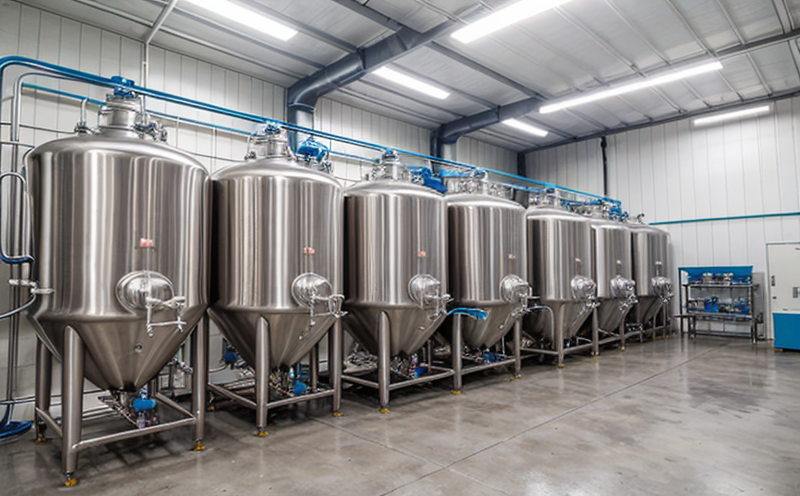EP 5.1.3 Efficacy of Antimicrobial Preservation in Biotech Products
The EP 5.1.3 test evaluates the efficacy of antimicrobial preservation methods used in biotechnology products, ensuring that the intended microbial population remains stable and effective over time. This is crucial for maintaining product safety, shelf-life, and effectiveness. The standard test protocol measures the reduction in viable microorganisms due to the presence of preservatives under defined conditions.
This test is particularly important in industries where long-term storage or transportation is required, such as pharmaceuticals, biopharmaceuticals, cosmetics, and food products. It ensures that preservation methods are effective against various types of microorganisms, including bacteria, yeasts, and molds, thereby protecting the integrity and quality of biotech products.
The EP 5.1.3 test typically involves incubating samples under controlled conditions for a specified period, followed by microbial enumeration using appropriate culture media or other quantitative methods. The reduction in viable counts is compared against initial levels to determine efficacy.
A detailed understanding of the preservatives used and their known antimicrobial properties is essential for accurate testing. This includes knowledge of the mechanism of action, concentration range, and compatibility with the product matrix.
| Test Parameter | Description |
|---|---|
| Viable Microorganism Count | Determination of initial and final counts using appropriate culture media or quantitative methods. |
| Incubation Conditions | Temperature, humidity, and time duration for incubation under controlled conditions. |
| Preservative Concentration | The amount of preservative used in the formulation. |
| Sample Preparation | Mixing and homogenization to ensure uniform distribution of preservatives within samples. |
The results are reported as a percentage reduction in viable microorganism count, which provides insights into the effectiveness of the antimicrobial preservation method. This information is critical for quality assurance and compliance with regulatory requirements.
- Ensures product safety by maintaining microbial stability.
- Prolongs shelf-life through effective preservation.
- Achieves regulatory compliance by meeting established standards.
- Enhances product integrity, ensuring consistent performance over extended storage periods.
In summary, the EP 5.1.3 test is a vital tool for quality managers and R&D engineers in biotech industries to ensure that their products meet safety and efficacy standards. By accurately measuring the reduction of viable microorganisms due to preservatives, this test supports continuous improvement and innovation in product development.
Why It Matters
The EP 5.1.3 test is essential for ensuring that biotech products remain effective over extended storage periods without compromising safety or quality. Here’s why it matters:
Product Safety: Ensures that preserved microorganisms do not pose a risk to consumers.
Regulatory Compliance: Adherence to international standards like ISO, EN, and FDA guidelines is critical for market entry and ongoing compliance.
Prolonged Shelf-Life: Effective antimicrobial preservation extends the shelf-life of biotech products, reducing waste and improving cost-efficiency.
Consistency in Performance: Maintains consistent product performance even under challenging storage conditions.
Innovation Support: Provides data for R&D teams to refine and optimize preservation methods.
Industry Applications
| Application | Description |
|---|---|
| Pharmaceuticals | Evaluation of preservatives in injectables, ointments, and other dosage forms. |
| Biopharmaceuticals | Ensuring stability of biologics during long-term storage. |
| Cosmetics | Testing preservatives in creams, lotions, and other topical products. |
| Foods & Beverages | Efficacy testing for extended shelf-life products like jams, sauces, and dairy items. |
The EP 5.1.3 test is widely used across these industries to ensure that products maintain their quality and safety over extended storage periods. This table highlights the diverse applications of this important standard in biotech product development.
- Pharmaceuticals: Ensuring the stability of injectables, ointments, and other dosage forms.
- Biopharmaceuticals: Guaranteeing that biologics remain effective during long-term storage.
- Cosmetics: Testing preservatives in creams, lotions, and other topical products to ensure their effectiveness over time.
- Foods & Beverages: Evaluating the efficacy of preservatives in extended shelf-life products like jams, sauces, and dairy items.
These applications underscore the importance of this test across various sectors within biotechnology, highlighting its role in maintaining product quality and safety.
Why Choose This Test
The EP 5.1.3 test is a cornerstone for ensuring the efficacy of antimicrobial preservation methods used in biotech products. Here’s why it should be chosen:
Precision & Reliability: The test provides precise and reliable results, enabling accurate evaluation of preservative efficacy.
Standardization: Adherence to international standards ensures consistency and comparability across different laboratories and regions.
Innovation Support: Provides valuable data for R&D teams to innovate and improve preservation methods.
Regulatory Compliance: Ensures compliance with relevant regulations, facilitating market entry and ongoing adherence to legal requirements.
Cost-Efficiency: By ensuring product stability over extended storage periods, this test reduces waste and improves overall cost-efficiency for manufacturers.
Consistency in Performance: Maintains consistent performance of biotech products across different storage conditions and durations.
The EP 5.1.3 test is a critical tool for quality managers and R&D engineers, ensuring that their products meet the highest standards of safety, efficacy, and consistency.





